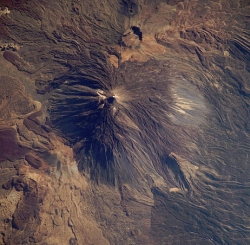
October Editorial
A trigger for explosive volcanic eruptions

October Editorial
A trigger for explosive volcanic eruptions
|
Few things in nature are as dangerous as a pyroclastic volcanic eruption. In such an eruption, a huge mass of rock and gas heated up to around 1000 degrees celsius pours from a volcano at speeds of up to 750 kmh incinerating everything in its path. Obviously, it would be a good idea not to be in the path of a pyroclastic eruption, but because of the speed of the flow, the only way to do this is to know when such a flow will occur. For a long time scientists have tried to understand what triggers a pyroclastic volcanic eruption, as this is the first step in predicting such an eruption, but so far they have tried in vain.
|
Now researchers from the University of Southampton think they have the answer. They have been studying samples from the Las Canadas volcanic caldera on Tenerife, in the Canary Islands. The Las Canadas volcanic caldera was chosen for the study because this volcano has generated a number of major Plinian eruptions. Some of the catastrophic events produced by this volcano have resulted in eruption columns of over 25 km high, depositing pyroclastic material over a radius of over 130 km. There have been eight pyroclastic events over a 700,000 year period. This has given the researchers a unique opportunity to compare material from these different eruptions. Previously the scientists were limited to analyses of lavas or individual crystals ejected during the eruptions. However this time, the group from Southampton University managed to recover samples of crystal cumulate nodules - igneous rocks formed by the accumulation of crystals in magma. |
|
|
These samples contained diverse crystalline deposits from all levels of the developing reservoir of material in the volcano which mixed with the final magma shortly before the eruptions. Analysis of the nodules consistently showed that within the magma chamber older, cooler magma mixed with younger, hotter magma prior to eruption, and that the mixing itself seemed to have triggered the large-scale eruptions. Working from three major explosive eruptions: Fasnia, Poris and La Caleta, the researchers identified crystal cumulate nodules in ignimbrites (A type of volcanic rock formed by the welding together of 'tuff' material from an explosive volcanic eruption.) The particular attention was given to plagioclase and clinopyroxene crystals. A plagioclase is a form of feldspar consisting of aluminosilicates of sodium and/or calcium, common in igneous rocks and typically white. Clinopyroxene, on the other hand, is a mineral of the pyroxene group, crystallizing in the monoclinic system. Pyroxene group mineral is common in mafic rocks, with a monoclinic crystal form. In plagioclase the researchers studied variations in Na:Ca:K (Sodium, Calcium potassium) concentration from the core to the rim of the nodule. In the Clinopyroxene they focused on variation in Mg:Fe:Ca (Magnesium, Iron, Calcium) Chemical analysis of the nodules showed that within crystal mantles, the concentration of calcium in relation to sodium (Ca/(Ca+Na) × 100) tended increase in plagiclase. Similarly the ratio of magnesium to iron (Mg/(Mg+Fe) × 100 ) in clinopyroxene was either flat or also slightly increased. However, moving from the mantle to the rim, there was a sharp decrease of calcium (Ca/(Ca+Na) × 100 is much lower) in plagiclase and a correspondingly sharp drop in magnesium (lower Mg/(Mg+Fe) × 100) in clinopyroxene. What those results suggest is that whereas the inner part of the nodule is consistent with mafic (very hot) magmas, crystal edges consistently show the presence of more felsic (cooler) magmas. As Dr Rex Taylor, Senior Lecturer in Ocean and Earth Science at the University of Southampton explains: 'These nodules are special because they were ripped from the magma chamber before becoming completely solid -- they were mushy, like balls of coarse wet sand. Rims of crystals in the nodules grew from a very different magma, indicating that a major mixing event occurred immediately before eruption. Stirring young hot magma into older, cooler magma appears to be a common event before these explosive eruptions.' Co-author of this study, Dr Tom Gernon, Lecturer in Ocean and Earth Science at the University of Southampton, adds: 'The analysis of crystal nodules from the volcano documents the final processes and changes immediately prior to eruption -- those triggering the catastrophic eruptions. The very presence of mushy nodules in the pyroclastic deposits suggests that the magma chamber empties itself during the eruption, and the chamber then collapses in on itself forming the caldera.' You can read the full report of this study by following the link below. Journal Reference:
| |
| _______________________________ | ||||
| Home | | | Shopping | | | Database |
© Biscuit Software 2004-2015
All rights reserved